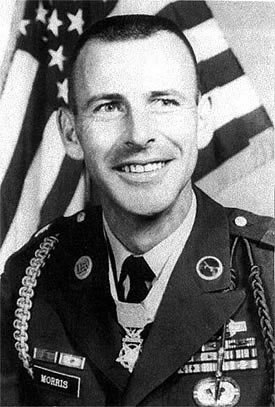
Richard Eller Cowan was a soldier in the United States Army who posthumously received the United States military's highest decoration, the Medal of Honor, for his actions during World War II.

Lucian Adams was a United States Army soldier during World War II who received the Medal of Honor for single-handedly destroying enemy machine gun emplacements to re-establish supply lines to U.S. Army companies. He also received the Bronze Star and Purple Heart for his heroic actions in Italy.
Truman O. Olson was a United States Army sergeant who was posthumously awarded the United States military's highest decoration, the Medal of Honor, for his actions in World War II.

Charles Bedford Morris was a United States Army soldier and a recipient of the United States military's highest decoration—the Medal of Honor—for his actions in the Vietnam War.

Nicholas Oresko was an American combat veteran of World War II who received the Medal of Honor for his valorous actions in Germany on January 23, 1945.

Wilburn Kirby Ross was a United States Army soldier and a recipient of the United States military's highest decoration—the Medal of Honor—for his actions in World War II.

Junior N. Van Noy was a United States Army soldier and a recipient of the United States military's highest decoration—the Medal of Honor—for his actions in the Battle of Finschhafen in World War II. His birthname was Nathan Kilby Van Noy Jr.

Ellis R. Weicht was a United States Army soldier and a recipient of the United States military's highest decoration—the Medal of Honor—for his actions in World War II.
Henry Fred Warner was a United States Army soldier who received the Medal of Honor for his actions during World War II.
James Daniel Slaton was a United States Army soldier and a recipient of the United States military's highest decoration—the Medal of Honor—for his actions in World War II.
Leo J. Powers was a United States Army soldier and a recipient of the United States military's highest decoration—the Medal of Honor—for his actions in World War II during the Battle of Monte Cassino.

George Peterson was a United States Army soldier and a recipient of the United States military's highest decoration—the Medal of Honor—for his actions in World War II.
Jack James Pendleton was a United States Army soldier and a recipient of the United States military's highest decoration—the Medal of Honor—for his actions in World War II.
Thomas Edward McCall was a United States Army soldier and a recipient of the United States military's highest decoration—the Medal of Honor—for his actions during the Battle of Monte Cassino in World War II.
Lewis R. Hall was a United States Army soldier and a recipient of the United States military's highest decoration—the Medal of Honor—for his actions in World War II.

Archer T. Gammon was a United States Army soldier and a recipient of the United States military's highest decoration—the Medal of Honor—for his actions in World War II.
John W. Dutko was a United States Army soldier and a recipient of the United States military's highest decoration—the Medal of Honor—for his actions in World War II.

Francis J. Clark was a United States Army soldier and a recipient of the United States military's highest decoration—the Medal of Honor—for his actions in World War II.
Chris Carr was a United States Army soldier and a recipient of the United States military's highest decoration—the Medal of Honor—for his actions in World War II.

Vito Rocco Bertoldo was a United States Army soldier. A veteran of World War II, he was a recipient of the Medal of Honor for his actions near Hatten, France, in January 1945.











